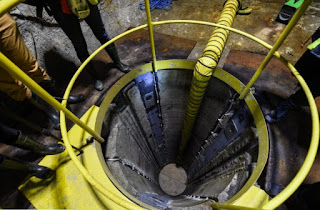Finland is building a nuclear waste site deep underground in the small town of Eurajoki. Called Onkalo, which means 'deep hole' in Finnish, the nuclear waste warehouse is scheduled to open in 2024.
If all goes according to plan, these underground barrels could be used to store spent uranium fuel rods for at least the next 100,000 years. But some experts question what happens when we bury nuclear waste, and how will this answer Finland's nuclear future?
Finland is a Scandinavian country with 5.5 million inhabitants. Their population is concentrated in the south, with only 200,000 people living around and above the Arctic Circle in northern Finland.
At a time when much of Europe was trying to escape nuclear energy sources, Finland embraced it. The fact is, Finland is facing an easier nuclear landscape. This is because the country has a relatively low population that few nuclear reactors can serve, thereby limiting exposure to any risks.
"Experts say Onkalo's success also reflects the unique cultural and political conditions in Finland, namely high trust in institutions, community involvement, lack of state-level power centers, and the balance of power between industry and stakeholders," the report said. Monday (14/3/2022).
Because of Finland's vast countryside and extensive coastline, the country has the perfect place to house the world's first reactor and permanent nuclear storage site, Olkiluoto.
On Olkiluoto there has been a nuclear power plant since 1979. The island has enough people around to keep things going. On the island is also Eurajoki, a village where a nuclear waste warehouse will be built.
"Almost everyone in Eurajoki has a friend or relative who has worked at a nuclear power plant, so they know how we operate," said Janne Mokka, who oversees the nuclear-related partnership.
Olkiluoto in the Gulf of Bothnia, is currently home to two nuclear reactors. Meanwhile, the third reactor will soon be operational. Together, the three reactors will supply more than 40% of Finland's power.
Photo: Popular Mechanics
So, it makes sense for Olkiluoto to also become a nuclear waste dump. The difference here is that Finland has received approval for the first permanent home for nuclear waste.
This process has taken decades, starting with site searches in the 1990s. Olkiluoto is a natural home for boiling water reactors, as these reactors require a steady stream of fresh and cold water for safety measures. For nuclear waste, water is actually the enemy. But Onkalo was dug deep into the nearly impermeable bedrock form that underlies the entire site.
The repository is located in this impermeable rock, and is deliberately centered, as far as possible from the two nearest earthquake faults. The actual waste storage process would involve drilling into the underground rock and then observing for cracks, even small, in the solid bedrock. If so, the specific location will not be used.
When the waste arrives at the site, it is first packaged in cast iron containers. After that, a layer of inert argon gas is introduced, then everything is enclosed in a sealed copper welded vessel.
The real concern is corrosion caused by oxygen, in this case, dissolved in the water itself. Experts say by the time the water makes it into the copper-covered vats of nuclear waste, the dissolved oxygen has already been consumed by bacteria and other agents working in the water.
"In Finland, the level of trust in science and authorities is very high. If the national authorities say the repository is safe, they don't have to worry about it," said political science researcher Matti Kojo.
"If you try to do the same in a country with a much lower level of trust in science and authority, it may fail."


